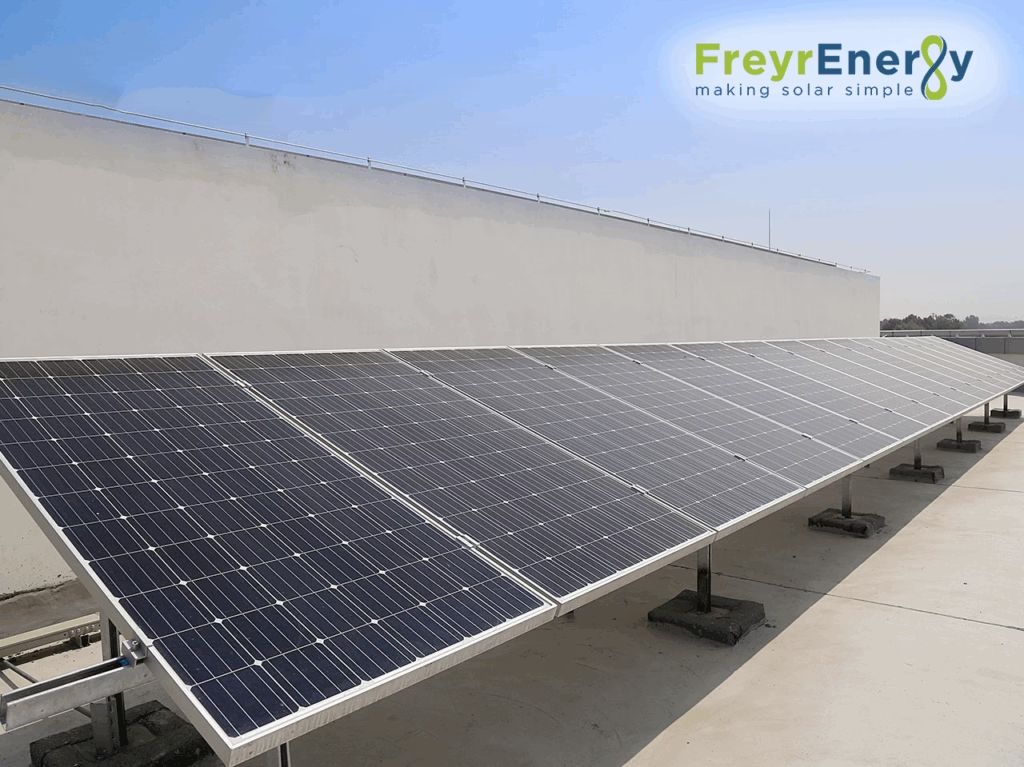From power cuts to power naps, discover how solar power in India overhauls the country’s energy landscape.
India has made significant strides in renewable energy, ranking 4th in the world’s most attractive renewable energy sectors. The country’s solar energy capacity has expanded exponentially over the last few years, with solar energy growing by 18 times in the previous seven and a half years. The Indian government has recognized the immense potential of solar energy and launched solar subsidy schemes to harness solar power in India.
India is one of the world’s largest electricity producers, and its solar power capacity has grown from 2.63 GW in 2014 to over 41 GW in 2021. This increase in solar power capacity is a testament to the vast potential of solar power in India.

Freyr Energy’s solar solutions reduce dependence on fossil fuels, require low maintenance, and provide dependable power, unlike hydro and wind. Additionally, solar power is easy and quick to install, making it an attractive option for urban and rural areas in India.
In this blog, we will explore how India is well on its way to achieving its renewable energy targets and becoming a leader in the global shift toward clean energy.
Present Scenario of Solar Power in India
In the present scenario, India added a record 10 GW of solar energy in 2021, achieving nearly 200% year-on-year growth and surpassing 50 GW of cumulative installed solar capacity.
One of the primary reasons for India’s aggressive progress in solar energy is its rapid development of solar power-based industries. The scope of new technological developments also ensures a decrease in costs and an increase in solar panel efficiency, further enhancing the usage of solar power in India.
The government of India has also announced an allocation of ₹ 5,331.5 crore in the Union Budget 2023 to boost the manufacturing of solar modules, demonstrating its commitment to promoting renewable energy and meeting its renewable energy targets.
Of this total, ground-mounted solar photovoltaic systems account for a staggering 42 GW, while rooftop and off-grid solar PV systems contribute only 6.48 GW and 1.48 GW, respectively.
With fast development, new technological advancements, increasing investment, and declining costs, solar power in India is set to achieve even greater heights in the years to come.
Expansion of Solar Power in India
Solar power in India has been experiencing significant growth in recent years.
The country has emerged as one of the largest producers of electricity in the world. However, despite its large-scale power generation capacity, India still struggles to meet its solar power plant needs.
India’s efforts to expand its solar power plant capacity have been impressive, with over 12 GW of solar photovoltaic (PV) installed in the financial year 2022 alone. This is expected to surge to more than 20 GW in FY2023, which demonstrates the country’s commitment to ramping up its solar power plant capacity.
India’s cumulative installed solar power plant capacity surpassed 64,380 MW as of February 28, 2023, up from just 2.63 GW in 2014. A scheme for “Development of Solar Parks and Ultra Mega Solar Power Projects” is under implementation to facilitate large-scale grid-connected solar power plant projects with a target capacity of 40 GW by March 2024.
Solar power plant with a cumulative capacity of over 10 GW has already been commissioned in 17 parks, with the remaining parks at various stages of implementation. The Indian government has also been distributing solar study lamps and installing solar street lights to enhance the adoption of solar power in the country.
On top of that, let’s delve into the key factors influencing the future of solar energy in India:
- Foreign Direct Investment in the Solar Panel System Sector: India is one of the top destinations for foreign direct investment in the solar sector. The Indian government has introduced several measures to attract foreign investment, including subsidies.
- Role of the Private Sector in Promoting Renewable Energy: The private sector in India is playing an increasingly important role in promoting renewable energy. Many private companies are investing in solar power plant in India and are also setting up their solar panel system to meet their energy needs.
- Geographical Advantage: India’s geographical location makes it an ideal destination for solar power. The country receives an average of 300 sunny days per year, making it one of the sunniest countries in the world.
- Aatma Nirbhar Mission of India: The Indian government’s Aatma Nirbhar mission aims to promote self-reliance and reduce dependence on imports. As part of this mission, the government is promoting the domestic production of the solar panel system and reducing the country’s reliance on imports.
Challenges in Scaling up Solar Energy
Solar energy in India has made great strides in recent years, with significant growth in installed solar capacity. However, the contribution of solar energy to the country’s power generation has not kept pace with this growth.
In Q1 2022, solar power accounted for only 13.22% of India’s total power generation. Let’s analyze the challenges and solutions in scaling up solar energy in India:
- Challenges faced by Utility-scale Solar PV Sector: The utility-scale solar PV sector in India faces numerous challenges, including high land costs, high transmission, and distribution losses, grid integration challenges, conflicts with local communities, and biodiversity protection norms.
- Rooftop Solar as a Solution: In recent years, rooftop solar has emerged as a popular solution to crush many of the challenges associated with scaling up solar energy. Rooftop solar systems can be installed on individual homes and buildings, providing a decentralized energy source closer to the point of use.
- The potential of Rooftop Solar: The cost of rooftop solar has declined significantly in recent years, making it more affordable for households to install solar systems. Rooftop solar has the potential to provide a significant share of India’s energy needs and help the country transition to a more sustainable energy future.
Freyr Energy’s Role in Advancing the Solar Energy Sector
Freyr Energy is a leading Engineering, Procurement, and Construction (EPC) company in India that has been instrumental in promoting the use of solar energy among residential, commercial, and industrial customers. Here are some ways Freyr Energy has been contributing to making solar energy more affordable:
- Affordable Solar Panel Cost: Freyr Energy offers competitive pricing and affordable solar panel cost for its solar panel system, making it easier for customers to switch to solar energy without breaking the bank.
- High-quality Solar Panels: Freyr Energy is committed to following global standards of quality and processes. With investors like Total Energy and Schneider Electric, Freyr Energy ensures that its solar panels are of the highest quality and meet international standards.
- Financing Options: Freyr Energy understands that not everyone has the resources to invest in a solar panel system upfront. That’s why we offer financing options that make it easier for customers to afford solar panel costs.
- Technology-based Approach: Freyr Energy makes the customer’s journey seamless and transparent with its technology-based approach. Customers can pay online, track the progress of system installation online, and even track generation online.
- Dedicated Teams: Freyr Energy has dedicated teams for each functionality, ensuring that every customer gets the best possible service and support
By offering affordable solar panel systems and solar panel financing options, Freyr Energy is playing a significant role in making solar energy more accessible to all.
Frequently Asked Questions
Solar energy is a bright future for India as the country has high solar irradiance, ample land availability, and an increasing need for electricity.
Yes, India’s solar industry is growing fast, with the country adding significant capacity in recent years.
Yes, India is a good place for solar energy due to its abundant sunlight, favourable policies, and a growing need for electricity.
Some of the government schemes and incentives to promote solar energy adoption in India include the National Solar Mission, Solar Parks, Net Metering, and subsidies for residential rooftop solar systems.



